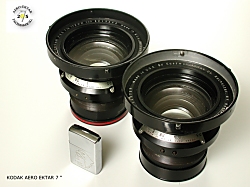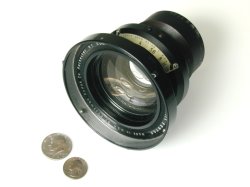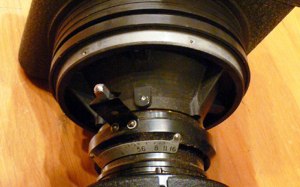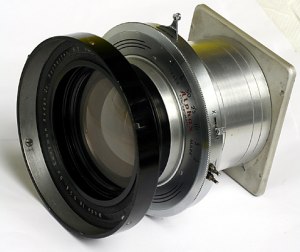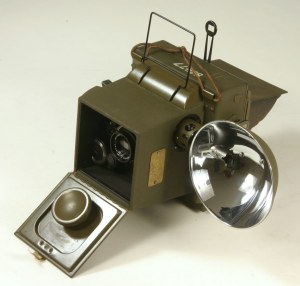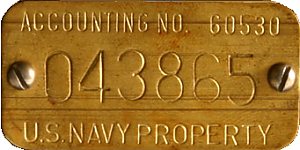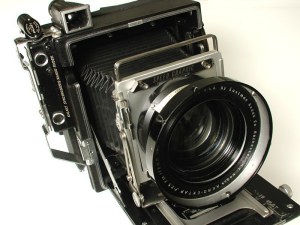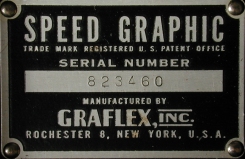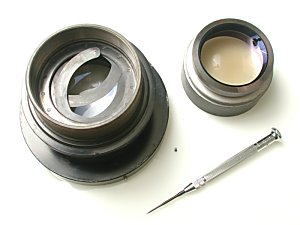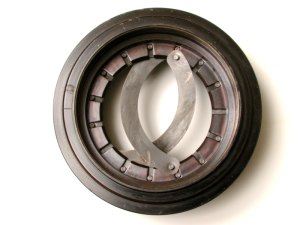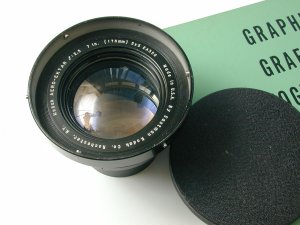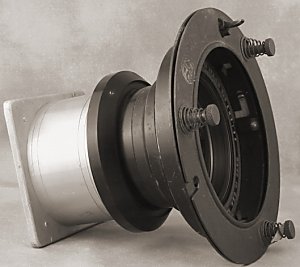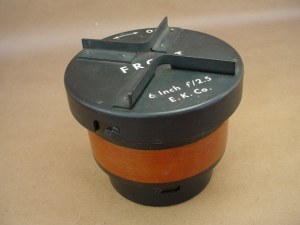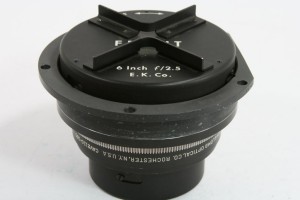

 |
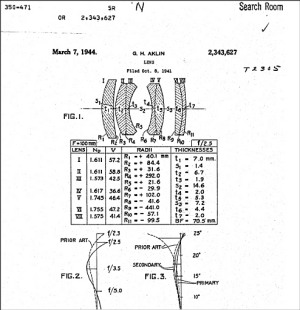 |
 |
Patent issued 1944
Full name:
Kodak Aero-Ektar f2.5 7in (178mm) 5x5 EE ****,
Made in
USA by Eastman Kodak Co., Rochester, N.Y.
According the prescription USP 2,343,627
(Aklin/Kodak) it is a seven element Biotar type.
It has 6 stops: 2.5, 4.0, 5.6, 8.0, 11.0, 16.0 llllllllllllllll
It is a tradition among optical designers to present lens designs for the focal
length 100 mm.
This way they can compare designs with a standard focal
length. To make it into the focal length 178 mm, multiply all dimensions by
1.78. To make it into the 12 in (305 mm) f2.5 version, multiply all dimensions
by 3.05. llllllllllllllll
|

 |
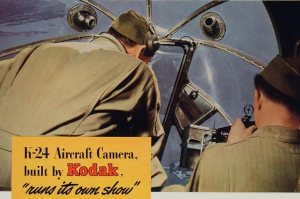 |
 |
Kodak advertisement 1944
Starring the K-24 with the Kodak Aero-Ektar f2.5 7in (178mm)
1944 Ad K-24 Kodak Aircraft Camera Bombardier Gunner
* Year: 1944
* Type: Original Print Ad
* NAIAA: Registered and Certified (S)
* Image: Color
* Size (inches): Approx. 10 x 13
Catch Phrase:
" The K-24 is no hero - the men who do the flying play that role. But it does take a lot off a hero's mind!"
|

 |
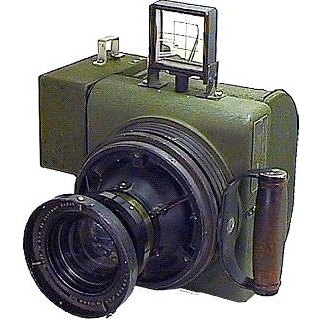
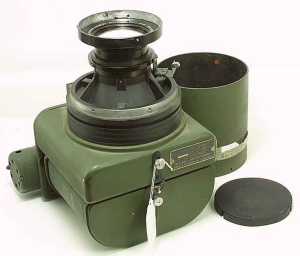
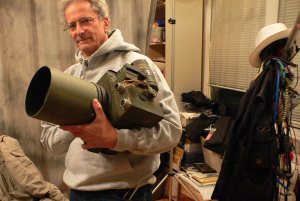
|
 |
Production
Production started somewhere in 1940. All Serno's start with capital E which stands for 4
CAMEROSITY - 1234567890 (use this coding to find year of production.)
The lens was designed and developed for the Aerial cameras a.o K24 during WWII and used with Flash-bombs for Rec. missions.
This a high quality lens made by Kodak for the American government.
The mega order did cost some green ones...Lenses were USD 800
If you look at the aperture you will understand, I've never seen a construction of 15 blades before and it is very unlikely they will be ever made again from today.
The K-24 shown here is a manual type and designed for 5x5In film. Most cameras however were electronically operated.(See below)
Complete cameras can be obtained from E-bay, prices from USD 199 and up. Shipment can be steep as weight exceeds lbs 30.
Lenses offered on Ebay are in demand and prices payed are rising...
llllllllllllllll
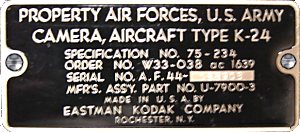
This is the electric version, hence it could be operated manual also.
Some specs:
Original Kodak Model K-24 Aerial Surveillance Camera. Camera was manufactured by Eastman Kodak Company, Rochester New York for the United States Army Air Forces for use during World War 2 (WWII) and it was used mostly in the B-17's , B-29's, B-24's and B-25's.
Because of the weight it required a camera mount. Camera was made to be both manual or electric driven, uses 5" format film,
has a Kodak F/2.5-178mm lens. (7") Camera has a Delco 24 volt direct driven motor unit, manufactured by General Motors,
and has original spec plate on side of lens. (See images for more details) Camera is approx. 15" x 11" x 10-1/2".
Camera was manufactured in 1944 and 45 and it comes in the original box with all the accesories (cables etc).
You wiill get an unopened box. Weights around 45 lbs, thus shipping will be high and can vary enormously depending on location.

Outtabox.... David recently acquired a late K-24 (1944)
Now you have a better understanding how huge these units really are.
These unopened boxes contain NOS (New Old Stock) cameras. David B., showing his new Camera, actually he will use the Kodak Aero Ektar only...if you are in need of a spare K-24 contact David Burnett!>
|


 |
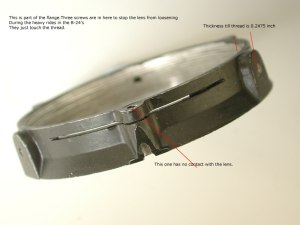 |
 |
Disassemble from flange II
Study the picture and handle with care, damaging the threads may result otherwise!
The only way to get the flange off is to drill them out.....But do this in steps and measure!
WARNING::
Before attempting this rigorous disassembly, check the images carefully.
If the threads are damaged, you can't get a retainer ring on it!!!
You might well risk the situation where you loose a fine lens and consign it to the trash heap if you tinker with it. Do what you must....but use great caution and be aware of the risk. Good luck.
llllllllllllllll
|

 |
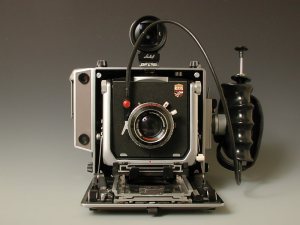
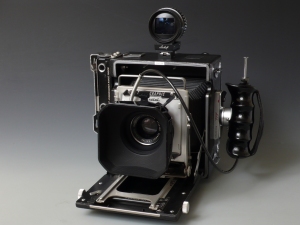

|
 |
Linhof Super Technika V 45/Master Technika
According many photographers this camera is the non plus ultra.
Allthough our Speed Graphic sometimes referred to as "The Poor Man's Technika" , I know as I own both camera's and as such have the authority to speak, the Pacemaker beats the Technika on one important feature at least - The focal plane shutter.
Simple construction but reliable and a must have to work with barrel lenses.
We have to disappoint Linhof owners who want to mount the Kodak Aero Ektar and want to experiment....Sorry, it won't work (Actually it is no problem to get the lens through the light trap - 81mm), as you still will need a big black hat to control the shutter time.
Take my word, it is by far the best solution to buy a Speed Graphic and use it exclusively with the Kodak Aero Ektar.
It helps you create that special Image which is not possible with your Linhof and can't be (Photo)shopped either...
My personal Technika with anatomical grip and universal viewfinder (Focal length: 75-90-135-150-180-210-300-360)
Many items can be interchanged with the Speed and vice versa.
The Linhof viewfinder and a Linhof anatomical grip will not only look superb on your Graphic but work very well....
Also you can use the a Graphic roll film back or Grafmatics on the Technika.
On the left my favorite PSG pimped with Technika accessories. (Actually only the viewfinder, the grip has been mounted permanently..)
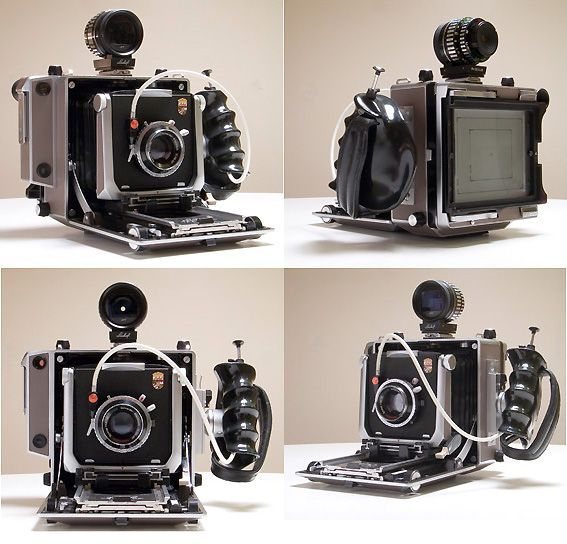
Technika V all sides JdesqClose
llllllllllllllll
|

 |
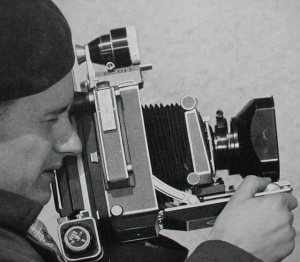 |
 |
Addendum on Master Technica 45
Linhof Technika 45 owners as said above can easily mount the Aero Ektar on a lensboard.
However the absence of a focal plane shutter is the big problem. However as I've come to learn there is a focal plane shutter....
Probably very scarce and expensive as well, the Focal plane unit can be be mounted directly at the International back the same way as the Super Rollex backs.
llllllllllllllll
|



 |
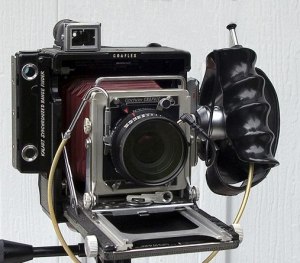 |
 |
Master Graf ???
Hybrid Camera? No way, just a Century Graphic (2-1/4x3-1/4). I must admit the anatomical grip is a nice add-on but at a price these days!
Modern plasmats can be used....
llllllllllllllll
|




 |
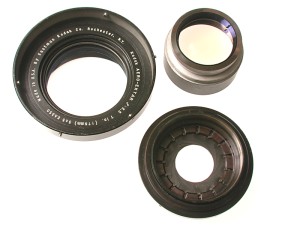
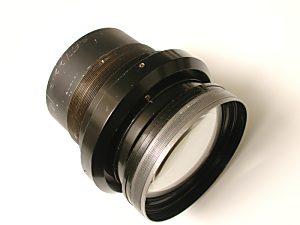
|
 |
Disassembled Kodak Aero Ektar (EA***)
| DISCLAIMER |
Dismantling is quite straightforward, however...
Using the wrong tools and applying force can easily damage your unique Kodak Aero Ektar. If in doubt, don't even think about it!
If you want to proceed be warned: You do these modifications and disassembling at your own risk!
llllllllllllllll
|
If neccessary to clean the lens from the inside, the lens must be taken apart.
Of course I know, a little dust on- or little glass bubbles in - the elements won't do much harm or interfere at all with actual image making but....I want my lenses as clean as possible and my Makers Mark without ice.
Dismantling the elements is not a walk in the park due to the bad state of the screws( Did not see any screws not tampered with!) .
I persevered however and managed to get the lens elements and the diaphragm tube apart.
Look for tiny screws - one on the back barrel and one in front. These are just screws to avoid movement on the front and back part of the lens.
If you are very lucky the screws are not damaged by pre owners...
Once removed it is not neccessary to replace them though...
I don't plan any rides in a B-25 shortly so there is little danger the elements will getting loose due to bumps and rocking while airborn in a flying fortress.
Modern plasmats have their front and rear lenses only screwed in the shutter also.
Of course you can use the screws to lock the barrels, but most of the time they will be damaged badly.
Eventually, the lens will come apart in 3 parts i.e Front lens, aperture barrel and back lens.
Click image left to get a clear view of the location of the screws.
To access the screw at the front element you have to unlock the black aperture ring beforehand!
The screw in front is partially hidden by the aperture ring and must be removed. Two screws are in here also, take them out and turn the ring till it clears the screw in front.
Hence, replacing the aperture ring might be tricky, you have to find the holes in the brass ring underneath. Making marks before you start will shorten assembling considerably!
llllllllllllllll
|

 |
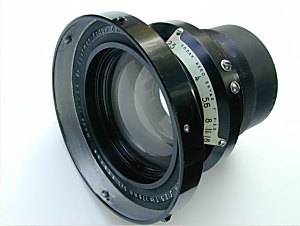 |
 |
Specs
We only can give the specs from the model we have EE.
One thing we know is that the lenshood in the earlier versions is not removeable. Note the numbering around the lens is closer to the glass elements as with the later versions. Also the aperture plate is not available on the earlier models.
Dimensions:
- Overall Length: 113 mm
- Width front Ø : 120 mm (With shade)
- Width front Ø : 084 mm (Without shade)
- Width back Ø : 074 mm
- Width back Ø : 078 mm (Incl. Thread)
- Weight : 1500 gram
- Back focus : BF 122.8 can differ....lens specific.
llllllllllllllll
|

....
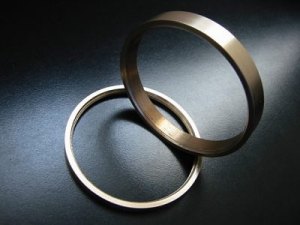 Mounting the Kodak Aero Ektar
Mounting the Kodak Aero Ektar
Aero Combo - refer as Mod II
#I Spacer and retaining ring
The whole project was discussed by extensive phone and E-mail communication with Jo Lommen (Jo is an expert on restoring Press Cameras and much more.)in Roermond (NL).
This was a very important start after buying the Kodak Aero Ektar EE*****. We looked over different possibilities to mount the beast. In our pursuit we've found images of David Burnett and came in contact. As David kindly shared photographs of his own configuration, we decided to go for this solution.
In our minds this was not extremely difficult to do but...
Jo's contact needed time and the machines had to be programmed in between huge commercial contracts. The right material had to be chosen etc..
The waiting payed off, resulting in very nice crafted rings.
Only one word.. jumps to our mind...AWESOME!
The rings were not made of steel but bronze instead. As the lens tube itself is made of bronze, steel on bronze could easily oxydate and could result in sticking a few days short of foreever...!
llllllllllllllll
|

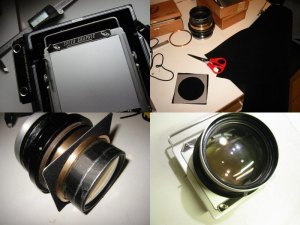 In progress....
In progress....
#II The lensboard
Construction.
The material used was brushed aluminium with a thickness of 1mm
The hole to be drilled must be 78mm . The backside was covered with black Decifix.
Eventual reflection should be absorbed now.
Comprehensive workout at
Jo's Site
llllllllllllllll
|


 |
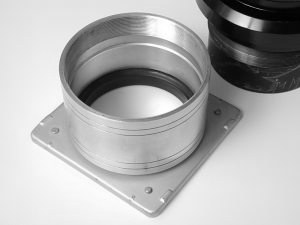

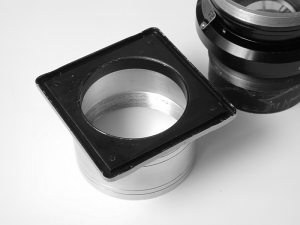
|  |
Alternate mounting solution. part II
Detailed view
Detail of the .above construction:
Front and rear assembly on original Pacemaker lensboard.
Mount the lensboard the usual way...and screw in the Aero to the end stop.
Checking GG for infinity while pulling out the front standard and lock.
Note:
We mentioned this before, this is the second best solution
It ressembles the mod and machining of Steve Grimes.
This solution was not new, it first appeared on the market in 1948 ref : Mod I
Shown here is the original board made by Graflex.
The unit clocks a mere 1600 g.
Ours is and remains the # 1 choice.
Part of the weight of the lens is behind the front panel. Also much more bellows draw for easier tilting..
|

 Click the image to see the details...
Click the image to see the details...
|

 |
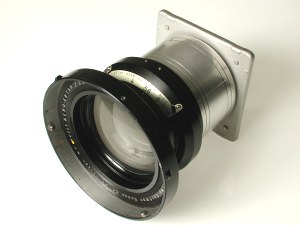
|  |
Mod I complete for rent...
Try before you leap.
Biggest advantange of this mount is, the lens can be used without any adaptions on the camera or lensboard!
If you live near John.D and own a Speed Graphic, it is possible to try this combination on your personal camera. Rental possible for 3 days(contiguous) at a reasonable price...
|

 |
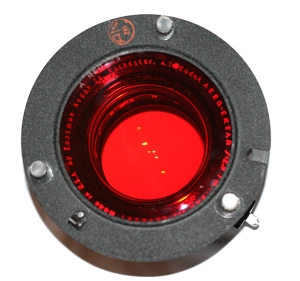 |
 |
Accessories and other paraphernalia... part IV
Filterholders
Can anybody shed some light on it? Yes, Oliver Kruse could, thank you Oliver!
This is the original filtermount for the K-24 Kodak Aero Ektar 7In.
Actually the glass drop -in filter has a diameter of 4 1/4 Inch.
The mount consists of two parts holding and securing the drop-in filter.
The thumbnails below can be enlarged telling the rest of the story...
|





 |
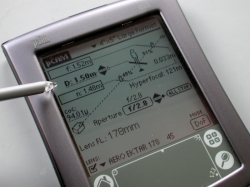

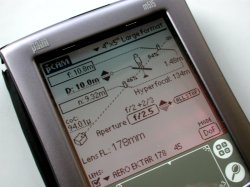
|  |
Working with the Kodak Aero Ektar f 2.5
A few notes
After you did mount the Aero and adjusted your Kalart RF you're ready to shoot!
Remember the Kalart when properly adjusted will focus to 6ft as the shortest distance.
Utilizing your Aero for the greatest fun,is working wide open i.e f2.5 - f2.8
If you stop down to f16 you can use any other lens...
Beware of the the very small dof at all times. To give a little understanding see our Palm screen.
If you focus within 6ft you need the GG and of course a tripod.
Focusing at 1.50 meter see the tip of the styli.
You will have an ample 4cm ....but an irresistible bokeh!
A second screen dump will show the Values for a distance of 10 meter.
If you use a palm already read below:
Pcam description:
David Eubank - 1st Camera Assistant - developer of pCAM, pCINE and Eubank's Log. ... Pcam is shareware.
www.davideubank.com
One more thing, even mounted on a sturdy tripod, try to avoid camera movement by using a long cable release.
Have fun!
|

 |
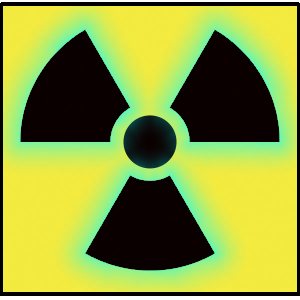 |
 |
Radio Activity
The rear elements of the Aero-Ektar lenses are famous for having thorium glass that is a mild gamma radiation emitter. This lens element does, indeed, emit gamma radiation, approximately 3 mR/hr. according to my Geiger counter. I looked into what exactly this means to the timid photographer. My brief web research indicates that if you put this lens in your (big) pocket for 8 hours a day, 5 days a week, after six months you would have been exposed to the 5000 mR maximum permissable annual occupational exposure. So, don't grind it up and eat it, use it for a pillow, make it part of your uniform, or put your body in contact with this device on a regular basis.
Beyond a couple feet away, the detected level of radiation disappears into the background.
llllllllllllllll
Exerpt from Michael S. Briggs
See our link
|

I want a Combo like this...:
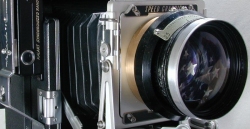
Mod II Combo
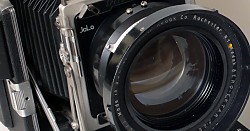
Mod IV Combo
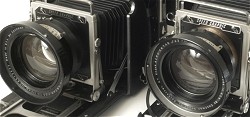
Click for Round-up

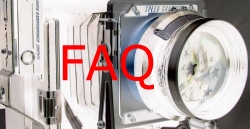
|
What do I need to build the Kodak Aero Ektar - Speed Graphic:
- A Pacemaker/Anniversary Speed Graphic with good working FP shutter.
- Kodak Aero Ektar 7" Lens
- Retainer ring
- Spacer
- Lensboard with a 78mm hole or
- All in one lensboard Mod IV
- Mask no 2 (optional)
- Adjusted Rangefinder for 178mm (Optional)
As you probably understand by now, this shopping list is not intended for your local Mall. Instead you have to google and search for the Speed Graphic, the Kodak Aero Ektar as well the Mask no 2.
The spacer, retaining ring and drilled lenshole will add some more difficulties, look out for a good machinist...
It takes a while to get it and a long while to get it right...
Recommended supplier is Jo Lommen - Roermond.
We get many requests about mounting and/or adapting the Kodak Aero Ektar 7In for the smaller formats (6x6cm and 35mm)
We give our comments right here to avoid unnecessary bandwidth ;-):
This lens was originally designed to shoot aerial
photography on 5 by 5 inch roll film. (9 by 9 inch for the 12In Kodak Aero Ektar)
Doing so and Shooting 35mm or 6x6cm is really underutilizing these lenses.
Only a small part of the image circle would be used this way!
Someone with machinist access should modify it for 4x5 or 5x7 film formats! Slight vignetting will occur on 5x7!
If you want to do M=1 on a 8x10 ..no problem It will cover the format with ease.
More on our page about the Image Circle.
|
















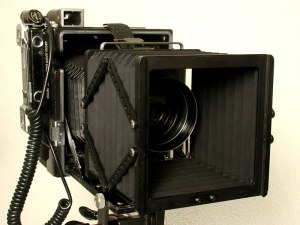

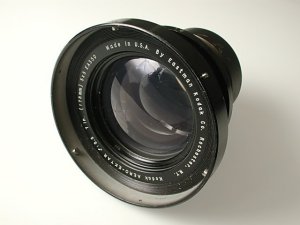




 Mounting the Kodak Aero Ektar
Mounting the Kodak Aero Ektar
 In progress....
In progress....


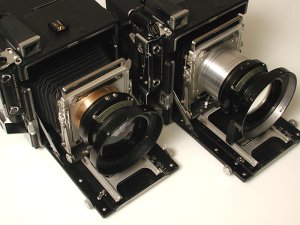

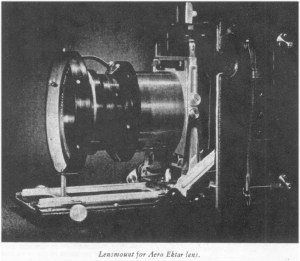





 Click the image to see the details...
Click the image to see the details...











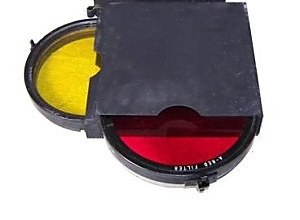

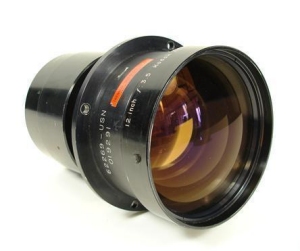
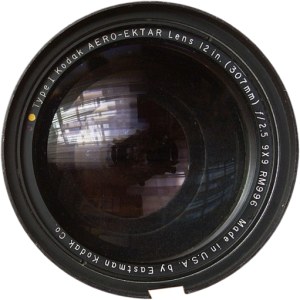

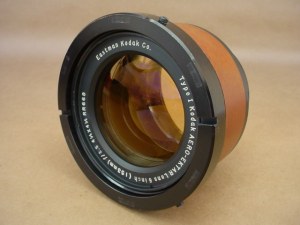

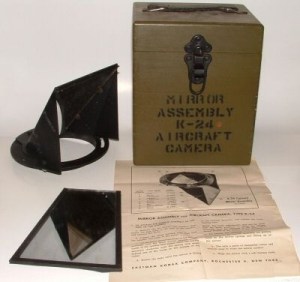









![]()


 Legal!
Legal!
 About
About
 Tribute MB
Tribute MB
 Whois
Whois
 Aldis
Aldis
 Aero Project
Aero Project
 The Workout
The Workout
 Memorandum
Memorandum
 Image Circle
Image Circle
 TestBench
TestBench
 Gallery
Gallery 
 Encounter...
Encounter...
 "User Group"
"User Group"
 User Group/Signup
User Group/Signup
 Promo Movie
Promo Movie
 Tribute
Tribute
 Graflens
Graflens
 Lenses+
Lenses+
 Holes+
Holes+
 My Pacemakers
My Pacemakers
 Books
Books
 Speedlights
Speedlights
 UserGallery
UserGallery
 WICF
WICF
 Contact
Contact
 Acquire
Acquire
 ABC
ABC
 Filmholders
Filmholders
 Whatsnew
Whatsnew
 Graflinks
Graflinks
 Start Page
Start Page
 Dancing with Speeds
Dancing with Speeds
 Femke
Femke
